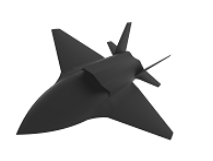Diseño de aeronave de combate no tripulada de quinta generación para el apoyo aéreo cercano
DOI:
https://doi.org/10.18667/cienciaypoderaereo.693Palabras clave:
aeronave no tripulada, apoyo aéreo cercano, furtividad, militarResumen
La evolución en el diseño de aeronaves de combate se ha visto modificada por la inclusión de nuevos parámetros de alta exigencia, dentro de los cuales se incluyen las áreas de investigación relacionadas con la aerodinámica, la furtividad y la optimización en los procesos de operación. El presente artículo contempla el diseño de un Vehículo de Combate Aéreo no Tripulado (UCAV) para la ejecución de misiones de Apoyo Aéreo Cercano (CAS por sus siglas en inglés) en las próximas décadas. Los resultados obtenidos demuestran las habilidades de los UCAV como aeronaves de quinta generación para el reemplazo de flotas reconocidas a nivel mundial (A-10 Thunderbolt II y Sukhoi Su-25) y, además, garantiza su utilidad y viabilidad en los futuros entornos de combate. Así mismo, la investigación se enfoca en una de las variables de mayor discusión respecto a la supervivencia en el combate aéreo, se trata de la furtividad por fenómenos electromagnéticos, con la cual se obtuvieron valores de Sección Equivalente de Radar (RCS) iguales a -24,18 dBsm o representables en un área de detectabilidad de 0,0038 m2 en configuración limpia, de modo que este valor es inferior al de aeronaves furtivas como lo es el Northrop Grumman B-2 Spirit. Finalmente, el diseño permite la operación con un máximo peso de despegue de 61,900 lb y una carga paga de 11,240 lb que se acondicionan a una configuración alar y de estabilizadores para rangos transónicos.
Descargas
Referencias
Atique, M. S. A., Barman, S., Nafi, A. S., Bellah, M., & Salam, M. A. (2016, 12 de julio). Design of a fifth generation air superiority fighter. AIP Conference Proceedings, 1754. https://doi.org/10.1063/1.4958444
Airforce Magazine. (2019). B-2 at 30: Improving with Age. https://www.airforcemag.com/PDF/MagazineArchive/Magazine%20Documents/2019/July%202019/0719_B-2%20for%20DR.pdf
Au, T. A., Hoek, P. J., & Lo, E. H. S. (2018). Combat Analysis of Joint Force Options using Agent-Based Simulation. 2018 Military Communications and Information Systems Conference (MilCIS), 1-7. https://doi.org/10.1109/milcis.2018.8574114
Biswas, K. (2020). Military Aviation Principles. Military Engineering, 1. https://doi.org/10.5772/intechopen.87087
Bravo-Mosquera, P. D., Cerón-Muñoz, H. D., Díaz-Vázquez, G., & Martini Catalano, F. (2018). Conceptual design and CFD analysis of a new prototype of agricultural aircraft. Aerospace Science and Technology, 80, 156-176. https://doi.org/10.1016/j.ast.2018.07.014
Chairman of the Joint Chiefs of Staff (CJCS). (2014). Close Air Support (Joint Publication 3-09.3 ed.). Defense Department Intelligence and Security. https://fas.org/irp/doddir/dod/jp3_09_3.pdf
Chatzigeorgiadis, F. & NAVAL POSTGRADUATE SCHOOL MONTEREY CA. (2004). Development of Code for a Physical Optics Radar Cross Section Prediction and Analysis Application. Van Duuren Media.
Chen, S., Yue, K., Hu, B., & Guo, R. (2015). Numerical Simulation on the Radar Cross Section of Variable-Sweep Wing Aircraft. Journal of Aerospace Technology and Management, 7(2), 170-178. https://dx.doi.org/10.5028/jatm.v7i2.416
Chen, W. (2004). The Electrical Engineering Handbook. ELSEVIER Academic Press.
Cidrás-Estévez, J. (2019). Herramienta Informática para el Diseño Conceptual de Aeronaves de Tipo Subsónica y Estudio de las Actuaciones. Universidad de Cádiz. https://rodin.uca.es/xmlui/handle/10498/22567?locale-attribute=es
Correll, J. (2019, 5 diciembre). The Ups and Downs of Close Air Support. Air Force Magazine. https://www.airforcemag.com/article/the-ups-and-downs-of-close-air-support/
Cummings, R. M., Liersch, C. M., Schütte, A., & Huber, K. C. (1994). Two-equation eddy-viscosity turbulence models for engineering applications. AIAA Journal, 32(8), 1598-1605. https://doi.org/10.2514/3.12149
Deskin, W., & Yankel, J. (2002). Development of the F-22 Propulsion System. 38th AIAA/ASME/SAE/ASEE Joint Propulsion Conference & Exhibit, 1-10. https://doi.org/10.2514/6.2002-3624
Sathyamoorthy , D. (2015). A Review of Security Threats of Unmanned Aerial Vehicles and Mitigation Steps. The Journal of Defence and Security, 6(1), 81-97. https://www.researchgate.net/publication/282443666_A_Review_of_Security_Threats_of_Unmanned_Aerial_Vehicles_ and_Mitigation_Steps
Dirwan, A. (2020). The Analysis of Fighter Aircraft Require- ment and Pilot Training for Indonesia’s Air Area Security. International Journal of Solid State Technology, 63(3), 1.631-1.632. http://eprints.universitassuryadarma.ac.id/478/1/9_Dirwan.EPrint.pdf
Fields, N. R. (2012). Advantages and challenges of unmanned aerial vehicle autonomy in the Postheroic age [Tesis doctoral. James Madison University]. https://commons.lib.jmu.edu/master201019/205/
Green, J., & Zeckhauser, R. (2019). Thunder Versus Lightning: A Performance and Cost Analysis of the A-10 “Warthog” Versus the F-35 Joint Strike Fighter. Journal of Benefit-Cost Analysis, 10(3), 434-468. https://doi.org/10.1017/bca.2019.27
Ho, O. (2018). Future Air Force Close Air Support Aircraft. The Faculty of the Department of Aerospace Engineering San José State University. https://apps.dtic.mil/sti/pdfs/AD1104495.pdf
Jenn, D. (2019). Radar and laser cross section engineering (3th ed). AIAA Education Series.
James, D. L., & Gouré, D. (2019). The Implications of Fifth-Generation Aircraft for Transatlantic Airpower A Primer. Atlantic Council. https://www.atlanticcouncil.org/wp-content/uploads/2019/10/FINAL-Air-Power-Domain-Report-WEB-1.pdf
Kong, W., Zhou, D., Yang, Z., Zhang, K., & Zeng, L. (2020). Maneuver Strategy Generation of UCAV for within Visual Range Air Combat Based on Multi-Agent Reinforcement Learning and Target Position Prediction. Applied Sciences, 10(15), 5198. https://doi.org/10.3390/app10155198
Liangliang, C., Kuizhi, Y., Weigang, G., & Dazhao, Y. (2016). Integration analysis of conceptual design and stealth-aerodynamic characteristics of combat aircraft. Journal of Aerospace Technology and Management, 8(1), 40-48. https://doi.org/10.5028/jatm.v8i1.514
Lockheed Martin Corporation. (2021). F-22 Raptor Digital, Dominant, Ready. Lockheed Martin Corporation. https://www.lockheedmartin.com/en-us/products/f-22.html
Nordhagen, L. C. (2018). A-10 Adaptive Basing Operations and Applications in Support of SOF. Naval Postgraduate School. https://apps.dtic.mil/sti/citations/AD1069675
Northrop Grumman. (2021). A-10 Thunderbolt II Specifications. Northrop Grumman. https://www.northropgrumman.com/what-we-do/air/a10-thunderbolt/
Rani, C., Modares, H., Sriram, R., Mikulski, D., & Lewis, F. L. (2016). Security of unmanned aerial vehicle systems against cyber-physical attacks. Journal of Defense Modeling and Simulation, 13(3), 331-342. https://doi.org/10.1177/1548512915617252
Raymer, D. P. (2018). Aircraft Design: A Conceptual Approach (Sixth Edition). American Institute of Aeronautics and Astronautics (aiaa).
Sepúlveda-Palacios, E., & Smith, H. (2019a). Conceptual design of a fifth generation unmanned strike fighter. AIAA Sci- tech 2019 Forum. https://doi.org/10.2514/6.2019-0811
Sepúlveda-Palacios, E., & Smith, H. (2019b). Impact of mission requirements on the design of low observable ucav configurations. Aircraft Engineering and Aerospace Technology, 91(10), 1295-1307. https://doi.org/10.1108/AEAT09-2018-0249
Touzopoulos, P., Boviatsis, D., & Zikidis, K. C. (2018). Constructing a 3D model of a complex object from 2D images, for the purpose of estimating its Radar Cross Section (rcs). Journal of Computations & Modelling, 1(1), 15-28.
Watts, B. D. (2013). The Evolution of Precision Strike. Center for Strategic and Budgetary Assessments. https://csbaonline.org/uploads/documents/Evolution-of-Precision-Strike-final-v15.pdf
Yaacoub, J.-P., Noura, H., Salman, O., & Chehab, A. (2020). Security analysis of drones systems: Attacks, limitations, and recommendations. Internet of Things, 11, 100218. https://doi.org/10.1016/j.iot.2020.100218

Publicado
Número
Sección
Licencia
Declaración de cesión de los derechos de autor a la revista
Los autores ceden la Revista los derechos de explotación (reproducción, distribución, comunicación pública y transformación) para explotar y comercializar la obra, entera o en parte, en todos los formatos y modalidades de explotación presentes o futuros, en todos los idiomas, por todo el periodo de vida de la obra y por todo el mundo.
Todos los contenidos publicados en la revista científica Ciencia y Poder Aéreo están sujetos a la licencia reconocimiento 4.0 Internacional de Creative Commons, cuyo texto completo se puede consultar en http://creativecommons.org/licenses/by/4.0/
La licencia permite a cualquier usuario descargar, imprimir, extraer, archivar, distribuir y comunicar públicamente este artículo, siempre y cuando el crédito se dé a los autores de la obra: a los autores del texto y a Ciencia y Poder Aéreo, Revista Científica de la Escuela de Postgrados de la Fuerza Aérea Colombiana. Excepto cuando se indique lo contrario, el contenido en este sitio es licenciado bajo una licencia Creative Commons Atribución 4.0 internacional.
Para usos de los contenidos no previstos en estas normas de publicación es necesario contactar directamente con el director o editor de la revista a través del correo cienciaypoderaereo@epfac.edu.
La Escuela de Postgrados de la Fuerza Aérea Colombiana y esta publicación no son responsables de los conceptos emitidos en los artículos, ni de los metadatos aportados ni de las filiaciones que los autores declaren, ya que esta es responsabilidad plena de los autores.





















